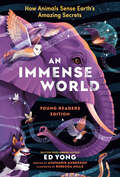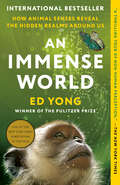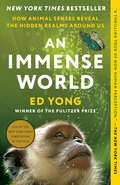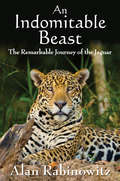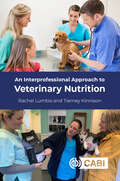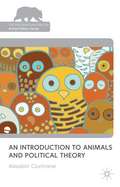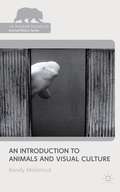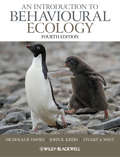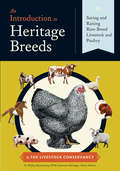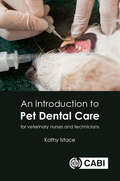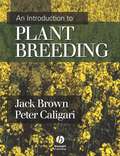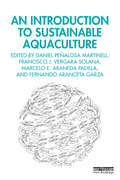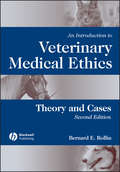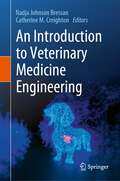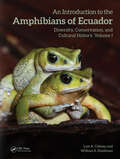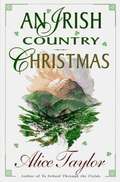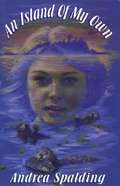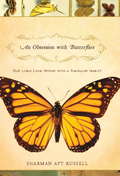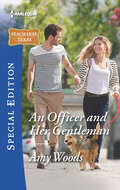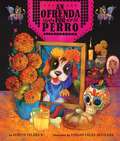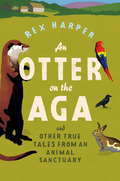- Table View
- List View
An Immense World (Young Readers Edition): How Animals Sense Earth's Amazing Secrets
by Ed YongThe New York Times bestseller now available with beautiful full-color illustrations for young readers! Explore the amazing ways animals see, hear, and feel the world, with Pulitzer Prize winner Ed Yong.Did you know that there are turtles who can track the Earth's magnetic fields? That some fish use electricity to talk to each other? Or that giant squids evolved their enormous eyeballs to look out for whales?The world is so much BIGGER and more "immense" than we humans experience it. We can only see so many colors, we can only feel so many sensations, and there are some senses we can't access at all.Exploring the amazing ways animals perceive the world is an excellent way to help understand the world itself. And this young readers adaptation of the mega-bestseller An Immense World is perfect for curious kids and their families. Sure to capture young readers' interest it is filled amazing animal facts and stunning full-color illustrations. Along the way are tons of amazing animals facts: Did you know that leopard pee smells like popcorn? That there is a special kind of shrimp whose punches are faster than a bullet? That it's important to take your dog for dedicated "smell walks?" Want to know the real reason zebras have stripes? (hint: it's not for camouflage)? Pick up this enthralling and enormously entertaining book to find out!A Junior Library Guild Gold Standard Selection
An Immense World: How Animal Senses Reveal the Hidden Realms Around Us
by Ed YongEnter a new dimension—the world as it is truly perceived by other animals—from the Pulitzer Prize-winning, New York Times bestselling author of I Contain Multitudes.&“A stunning achievement, steeped in science but suffused with magic.&”—Siddhartha Mukherjee, author of The GeneThe Earth teems with sights and textures, sounds and vibrations, smells and tastes, electric and magnetic fields. But every kind of animal, including humans, is enclosed within its own unique sensory bubble, perceiving but a tiny sliver of our immense world. In An Immense World, author and Pulitzer Prize–winning science journalist Ed Yong coaxes us beyond the confines of our own senses, allowing us to perceive the skeins of scent, waves of electromagnetism, and pulses of pressure that surround us. We encounter beetles that are drawn to fires, turtles that can track the Earth&’s magnetic fields, fish that fill rivers with electrical messages, and even humans who wield sonar like bats. We discover that a crocodile&’s scaly face is as sensitive as a lover&’s fingertips, that the eyes of a giant squid evolved to see sparkling whales, that plants thrum with the inaudible songs of courting bugs, and that even simple scallops have complex vision. We learn what bees see in flowers, what songbirds hear in their tunes, and what dogs smell on the street. We listen to stories of pivotal discoveries in the field, while looking ahead at the many mysteries that remain unsolved. Funny, rigorous, and suffused with the joy of discovery, An Immense World takes us on what Marcel Proust called &“the only true voyage . . . not to visit strange lands, but to possess other eyes.&”
An Immense World: How Animal Senses Reveal the Hidden Realms Around Us
by Ed YongEnter a new dimension—the world as it is truly perceived by other animals—from the Pulitzer Prize-winning, New York Times bestselling author of I Contain Multitudes. <p><p> The Earth teems with sights and textures, sounds and vibrations, smells and tastes, electric and magnetic fields. But every kind of animal, including humans, is enclosed within its own unique sensory bubble, perceiving but a tiny sliver of our immense world. <p><p>In An Immense World, author and Pulitzer Prize–winning science journalist Ed Yong coaxes us beyond the confines of our own senses, allowing us to perceive the skeins of scent, waves of electromagnetism, and pulses of pressure that surround us. We encounter beetles that are drawn to fires, turtles that can track the Earth’s magnetic fields, fish that fill rivers with electrical messages, and even humans who wield sonar like bats. <p><p>We discover that a crocodile’s scaly face is as sensitive as a lover’s fingertips, that the eyes of a giant squid evolved to see sparkling whales, that plants thrum with the inaudible songs of courting bugs, and that even simple scallops have complex vision. <p><p>We learn what bees see in flowers, what songbirds hear in their tunes, and what dogs smell on the street. We listen to stories of pivotal discoveries in the field, while looking ahead at the many mysteries that remain unsolved. <p><p>Funny, rigorous, and suffused with the joy of discovery, An Immense World takes us on what Marcel Proust called “the only true voyage . . . not to visit strange lands, but to possess other eyes.” <p> <b>New York Times Bestseller</b>
An Indomitable Beast: The Remarkable Journey of the Jaguar
by Alan RabinowitzThe jaguar is one of the most mysterious and least-known big cats of the world. The largest cat in the Americas, it has survived an onslaught of environmental and human threats partly because of an evolutionary history unique among wild felines, but also because of a power and indomitable spirit so strong, the jaguar has shaped indigenous cultures and the beliefs of early civilizations on two continents. In An Indomitable Beast: The Remarkable Journey of the Jaguar, big-cat expert Alan Rabinowitz shares his own personal journey to conserve a species that, despite its past resilience, is now on a slide toward extinction if something is not done to preserve the pathways it prowls through an ever-changing, ever-shifting landscape dominated by humans. Rabinowitz reveals how he learned from newly available genetic data that the jaguar was a single species connected genetically throughout its entire range from Mexico to Argentina, making it unique among all other large carnivores in the world. In a mix of personal discovery and scientific inquiry, he sweeps his readers deep into the realm of the jaguar, offering fascinating accounts from the field. Enhanced with maps, tables, and color plates, An Indomitable Beast brings important new research to life for scientists, anthropologists, and animal lovers alike. This book is not only about jaguars, but also about tenacity and survival. From the jaguar we can learn better strategies for saving other species and also how to save ourselves when faced with immediate and long-term catastrophic changes to our environment.
An Interprofessional Approach to Veterinary Nutrition
by Tierney Kinnison Rachel LumbisIn veterinary practice, the interface between veterinarians, veterinary nurses or technicians, and paraprofessional team members is crucial. It influences patient care, incidence of medical errors, client satisfaction, success of the veterinary practice and revenue generation. Ensuring a coherent approach to the maintenance of animal health and wellbeing is of paramount importance, yet challenges such as interprofessional prejudice, misunderstanding of motivations, and a lack of recognition, respect, empowerment or trust, can prevent best practice. Nutrition is one of the most important considerations in the maintenance of health, and plays a critical role in disease management, patient recovery and hospital outcome; a reflection of its recognition as the fifth vital assessment. Owners are increasingly aware of the role of nutrition in optimising pet health, yet considerable misinformation can make this one of the most difficult aspects of pet ownership. Playing a central role as a source of expert information, veterinary healthcare teams must rise to the challenge of optimising pet nutrition. Effective interprofessional communication and collaboration is considered a key factor in the successful implementation of nutritional assessment, and a positive team environment founded on respect, trust and mutual support helps overcome challenges and provide the best outcome for both pets and their owners. This book provides evidence-based theory in an accessible and practical way to help veterinary healthcare teams implement interprofessional approaches to nutritional care and support.
An Introduction to Animal Behaviour
by Aubrey Manning Marian Stamp DawkinsWolves excitedly greet each other as members of the pack come together; a bumble bee uses its long tongue to reach the nectar at the base of a foxglove flower; a mongoose swiftly and deftly bites its prey to death; young cheetahs rest quietly together, very close to sleep. Now in full colour, this revised and updated edition of Manning and Dawkins' classic text provides a beautifully written introduction to the fundamentals of animal behaviour. Tinbergen's four questions of causation, evolution, development and function form the fundamental framework of the text, illustrated with fascinating examples of complex behavioural mechanisms. The authors provide accounts of all levels of behaviour from the nerve cell to that of the population. The strengths of An Introduction to Animal Behaviour as a textbook include its clear explanations and concise, readable text and the enthusiasm of the authors for their subject.
An Introduction to Animals and Political Theory
by Alasdair CochraneStructured around the five most important schools within contemporary political theory: liberalism, utilitarianism, communitarianism, Marxism and feminism,this is the first introductory level text to offer an accessible overview on the status of animals in contemporary political theory.
An Introduction to Animals and Visual Culture
by Randy MalamudA fascinating exploration of the way in which animals are 'framed' - contextualized, decontextualized - in contemporary visual culture. Written in a highly engaging style, this book challenges the field, dealing with some highly controversial aspects of animal exploitation and boldly examines material that is seldom discussed within animal studies.
An Introduction to Behavioural Ecology
by Nicholas B. Davies Stuart A. West John R. KrebsAdditional resources for this book can be found at: www.wiley.com/go/davies/behaviouralecologyThis textbook helped to define the field of Behavioural Ecology. In this fourth edition the text has been completely revised, with new chapters and many new illustrations and full colour photographs. The theme, once again, is the influence of natural selection on behaviour - an animal's struggle to survive and reproduce by exploiting and competing for resources, avoiding predators, selecting mates and caring for offspring, - and how animal societies reflect both cooperation and conflict among individuals.Stuart A. West has joined as a co-author bringing his own perspectives and work on microbial systems into the book.Written in the same engaging and lucid style as the previous editions, the authors explain the latest theoretical ideas using examples from micro-organisms, invertebrates and vertebrates. There are boxed sections for some topics and marginal notes help guide the reader. The book is essential reading for students of behavioural ecology, animal behaviour and evolutionary biology.Key Features:Long-awaited new edition of a field-defining textbookNew chapters, illustrations and colour photographsNew co-authorFocuses on the influence of natural selection on behavior, and how animal societies reflect both cooperation and conflict among individuals"The long-awaited update to a classic in this field is now here, presenting new directions in thinking and addressing burning questions. Richly informed by progress in many other disciplines, such as sensory physiology, genetics and evolutionary theory, it marks the emergence of behavioural ecology as a fully fledged discipline..... This is a marvellous book, written in a lucid style. A must-read for those in the field, it is also a cornucopia of new thinking for anyone interested in evolution and behaviour."Manfred Milinski, Nature, 2012
An Introduction to Behavioural Ecology
by Nicholas B. Davies Stuart A. West John R. KrebsThis textbook helped to define the field of Behavioural Ecology. In this fourth edition the text has been completely revised, with new chapters and many new illustrations and full colour photographs. The theme, once again, is the influence of natural selection on behaviour – an animal's struggle to survive and reproduce by exploiting and competing for resources, avoiding predators, selecting mates and caring for offspring, – and how animal societies reflect both cooperation and conflict among individuals. Stuart A. West has joined as a co-author bringing his own perspectives and work on microbial systems into the book. Written in the same engaging and lucid style as the previous editions, the authors explain the latest theoretical ideas using examples from micro-organisms, invertebrates and vertebrates. There are boxed sections for some topics and marginal notes help guide the reader. The book is essential reading for students of behavioural ecology, animal behaviour and evolutionary biology. Key Features: Long-awaited new edition of a field-defining textbook New chapters, illustrations and colour photographs New co-author Focuses on the influence of natural selection on behavior, and how animal societies reflect both cooperation and conflict among individuals “The long-awaited update to a classic in this field is now here, presenting new directions in thinking and addressing burning questions. Richly informed by progress in many other disciplines, such as sensory physiology, genetics and evolutionary theory, it marks the emergence of behavioural ecology as a fully fledged discipline….. This is a marvellous book, written in a lucid style. A must-read for those in the field, it is also a cornucopia of new thinking for anyone interested in evolution and behaviour.” Manfred Milinski, Nature, 2012
An Introduction to Flapping Wing Aerodynamics
by Wei Shyy Hikaru Aono Chang-kwon Kang Hao Liu Wei Shyy Hikaru Aono Chang-Kwon KangThis is an ideal book for graduate students and researchers interested in the aerodynamics, structural dynamics and flight dynamics of small birds, bats and insects, as well as of micro air vehicles (MAVs), which present some of the richest problems intersecting science and engineering. The agility and spectacular flight performance of natural flyers, thanks to their flexible, deformable wing structures, as well as to outstanding wing, tail and body coordination, is particularly significant. To design and build MAVs with performance comparable to natural flyers, it is essential that natural flyers' combined flexible structural dynamics and aerodynamics are adequately understood. The primary focus of this book is to address the recent developments in flapping wing aerodynamics. This book extends the work presented in Aerodynamics of Low Reynolds Number Flyers (Shyy et al. 2008).
An Introduction to Heritage Breeds: Saving and Raising Rare-Breed Livestock and Poultry
by Alison Martin D. Phillip Sponenberg DVM Jeannette BerangerDeveloped for the particular needs of the working farm, heritage breeds have proved invaluable to small-scale agricultural production for centuries. This comprehensive guide explains why conserving heritage breeds remains important and how they often can be a better choice for the modern farmer than conventional animals. With profiles of heritage poultry, sheep, cattle, and more, you’ll learn how to select and successfully raise the breed that is right for your specific needs. Enjoy the benefits of resilient livestock while preserving genetic diversity for future generations.
An Introduction to Pet Dental Care: For Veterinary Nurses and Technicians
by Kathy IstacePeriodontal disease is one of the most common diseases observed by small animal practitioners, and it is not uncommon for the veterinary technician to be the first line in oral health assessment and treatment. Despite this, current dentistry training for veterinary technicians and nurses is often very limited. This book explains the causes, consequences, prevention and treatment of pet dental diseases including periodontal disease, fractured teeth, tooth resorption, dental malocclusions, oral masses, jaw fractures, and other oral conditions. It covers: · Instruction in essential skills such as dental cleaning, charting, radiography, and equipment maintenance. · Advanced skills such as the administration of regional nerve blocks and periodontal treatments. · The aetiology and treatment of common oral conditions. Improving competence in veterinary dental skills benefits technicians, veterinary practices, owners and their pets. Explaining pet dental diseases in a relatable way, this book allows veterinary staff to relay important dental information to pet owners in a way they understand. Providing solutions to help prevent and manage pet dental diseases, it outlines treatment options, outcomes, and post-operative dental care.
An Introduction to Plant Breeding
by Jack Brown Peter CaligariPlants have been successfully selectively bred for thousands of years, culminating in incredible yields, quality, resistance and so on that we see in our modern day crops and ornamental plants. In recent years the techniques used have been rapidly advanced and refined to include molecular, cell and genetic techniques. An Introduction to Plant Breeding provides comprehensive coverage of the whole area of plant breeding. Covering modes of reproduction in plants, breeding objectives and schemes, genetics, predictions, selection, alternative techniques and practical considerations. Each chapter is carefully laid out in a student friendly way and includes questions for the reader. The book is essential reading for all those studying, teaching and researching plant breeding.
An Introduction to Sustainable Aquaculture
by Daniel Peñalosa Martinell Vergara-Solana, Francisco J Araneda Padilla, Marcelo E Fernando Aranceta GarzaThis new textbook provides an accessible introduction to sustainable aquaculture through its relationship with three key pillars: the environment, the economy, and society.As the demand for seafood keeps increasing, aquaculture is considered one of the most promising and sustainable ways to satisfy this demand with nutritious and high-quality food. It is important to understand, therefore, the wider role and impact aquaculture has on the environment, the economy, and society. The book begins by providing a foundational introduction to aquaculture and sustainability, discussing the complex and interdependent relationship that exists between the two. The core text of the book is divided into four parts which focus on the environment, economics, social impacts, and governance and technologies. Chapters examine key issues surrounding climate change, food security, new technologies, bioeconomics and risk analysis, international cooperation, employment, and animal welfare, with the book concluding with a chapter examining the future directions and challenges for the aquaculture industry. The book draws on global case studies and each chapter is accompanied by recommended reading and chapter review questions to support student learning.This book will serve as an essential guide for students of aquaculture, fisheries management, and sustainable food, as well as practitioners and policymakers engaged in sustainable fishery development.
An Introduction to Veterinary Medical Ethics
by Bernard E. RollinOne of the most difficult issues that confronts veterinarians and staff today concerns the profession's obligation to the animal and the sometimes conflicting demands from clients, peers and society. The veterinarian's role has become more complex with new ethical challenges posed by issues such as growing public awareness regarding animal welfare, increasing economic value of companion animals, growth of veterinary specialization, experimentation with alternative and complementary medicine, and concern for pain management and mental well-being of animals. Written by an acknowledged pioneer in veterinary ethics, An Introduction to Veterinary Medical Ethics addresses the ethical challenges that veterinarians face daily as they seek to balance obligations to animal, client, peers, society and self. The book offers a highly readable and approachable introduction to the nature of ethical theory, reasoning and decision-making, and its practical application to veterinary medicine. Now with over 100 real-life veterinary case histories and analysis, this edition also includes new discussions of animal pain, distress and happiness, ethics of critical care, alternative medicine, legal status and value of animals, and Aesculapian authority. An Introduction to Veterinary Medical Ethics: Theory and Cases, Second Edition is recommended as essential reading for all veterinary students and practitioners, as well as those interested in general animal welfare. New edition from an acknowledged pioneer in veterinary ethics; Addresses ethical challenges that veterinary medicine, with over 100 real-life cases; Includes new discussion of legal status and value of animals, alternative medicine, Aesculapian authority, ethics and critical care, and animal pain, distress and happiness; Ideal for veterinary students and practitioners
An Introduction to Veterinary Medicine Engineering
by Nadja Johnson Bressan Catherine M. CreightonDo cephalopods change color when under distress? Is the reptilian heart analogous to a diaphragm positive displacement pump? Are digital twins the answer for animal experimentation? This book explores the new field of veterinary engineering science and discusses how to better measure vital signs in exotic and companion animals. A vast opportunity exists for developing novel technologies that target reductions to the number of invasive procedures patients are subjected to. We examine improvements to animal care and enhancement of animal welfare while creating a more sustainable veterinary healthcare ecosystem. The authors address the challenges engineers face in designing healthcare equipment for animals and how the field of veterinary engineering contributes to traditional veterinary medicine. This book brings a novel field of engineering to train future veterinarians and engineers on design and application of technology to veterinary medicine.Serves as a learning resource for the training and education of veterinary students, veterinarians and engineersDemonstrates through experiments and case studies the merging point between engineering and veterinary medicineDiscusses concepts and issues associated with engineering and veterinary medicineIllustrates veterinary challenges using an engineering-design approachProvides examples of veterinary applications with successful outcomes, incorporating step-by-step directions for engineers
An Introduction to the Amphibians of Ecuador: Diversity, Conservation, and Cultural History
by William E. Duellman Luis A. ColomaAn Introduction to the Amphibians of Ecuador is the first of four volumes, which are comprehensive, well-illustrated, and authoritative works, making them invaluable to biologists, conservationists, and others. This initial volume delves into the cultural history of amphibians, encompassing ethnobatrachology and folklore, while summarizing the amphibian iconography found in Ecuadorian archaeology. Moreover, it covers topics such as bioprospecting, sustainable management, and biotrade activities. The history and present state of amphibian biology research are also addressed. Furthermore, it explores in comprehensive detail the rich amphibian diversity of Ecuador, providing a thorough review of biogeography, amphibian declines, and conservation.Subsequent volumes list the characteristics of each species, define each taxon, and compare them to similar other species. Natural history and reproductive behavior, where known, are described, as are data on vocalizations, larvae, and ontogenetic changes. Amphibian distributions are illustrated with physiographic maps with dots. Each volume addresses the declines, extinctions, and conservation status of each species and provides notations of their occurrence in reserves.KEY FEATURES Summarizes the ethnozoological aspects of amphibians Provides a thorough history of research Introduction to three volumes providing accounts for each of the 3 orders, 19 families, 78 genera, and over 650 species from Ecuador
An Irish Country Christmas
by Alice TaylorIn this holiday gift edition, Alice Taylor returns to share the warm glow of a child's Yuletide celebration. Her tales of the season and the Irish countryside sparkle with magic. [From The inside dust jacket Flaps:] "The magic of Christmas was out in the moonlit haggard with the cattle and down the fields with the sheep but most of all it was here in the holly-filled kitchen with the little battered crib under the tree and the tall candle lighting in the window. The candle was the light of Christmas and the key that opened the door into the holy night." Beloved by readers on both sides of the Atlantic for her warmly remembered tales of Irish childhood, Alice Taylor now returns to reacquaint us with the joyful glow of a child’s Yuletide celebration in An Irish Country Christmas. In these pages she conveys, as no other author can, the delight that lies in every detail of the festive season for a young child. Her Irish countryside is like an archetype of everyone’s ideal Christmas landscape: a world where the season came with holly bundles and real geese to capture for the holiday dinner. Most of all, her storytelling reminds us of the unsentimental, wondrous innocence of youth, where every snow-dusted corner holds a surprise, and the lighting of the Christmas candle marks the commencement of magic. If Charles Dickens had written from rural Ireland instead of
An Island of My Own
by Andrea SpaldingShort-listed for the 1999 Silver Birch Award and for the 2001 Manitoba Young Readers’ Choice Award Fifteen-year-old Rowan, the daughter of foreign correspondents in Africa, finds herself beached for a summer with her cousins near Tofino, British Columbia. Desperate for a summer project, she camps on a neighbouring island to monitor the progress of an endangered group of sea otters, further threatened by the development plans of a real estate agent trying to sell the property for tourism.
An Obsession With Butterflies: Our Long Love Affair With A Singular Insect
by Sharman Apt RussellButterflies have always served as a metaphor for resurrection and transformation, but as Sharman Apt Russell points out in this lyrical meditation, butterflies are above all objects of obsession. She reveals the logic behind our endless fascination with butterflies and introduces us to the legendary collectors and dedicated scientists who have obsessively catalogued new species of Lepidoptera. A luminous journey through an exotic world of passion and strange beauty, this is a book to be treasured by anyone who has ever experienced the enchantment of butterflies.
An Occasional Cow
by Polly HorvathImogene spends a summer in Iowa and finds that's it's way more exciting than she thought.
An Officer and Her Gentleman (Peach Leaf, Texas #2)
by Amy WoodsReturning home from war is hard—but she may just find some peace with a small-town dog trainer and a new four-footed friend . . .Readjusting to civilian life has been a struggle for former army medic Avery Abbott. Home in Peach Leaf, Texas, for two years now, she still struggles with her worsening PTSD. And then a shaggy mutt named Foggy—and a devastatingly handsome dog trainer named Isaac Meyer—change everything.From the moment Isaac finds beautiful Avery scared and shaking on a country road, suffering from a heartbreaking flashback, he feels a connection to her he can’t explain. Is it her bruised and battered heart? Her easy affection for the therapy dog he finds to help her? Isaac is unsure, but he vows to help her rebuild her life. What he doesn’t expect is that the sensitive veteran he has rescued is going to rescue his own heart right back . . .“Woods’ latest Peach Leaf, Texas novel is enlightening, joyful and heartbreaking . . . The handling of returning veterans’ issues plus the heroine’s falling in love with man and dog are unforgettable.”—RT Book Reviews
An Ofrenda for Perro
by Judith Valdés B.Losing a pet is hard, but this picture book told through a Day of the Dead celebration will show readers that the love they have for their beloved companion will always remain.Benito loves Perro. But when Perro passes away, Benito is heartbroken. During the Day of the Dead celebration, he tries to understand the meaning of the flores de cempasuchil, candles, pan de muertos, photographs, and sharing memories of departed loved ones. By creating his own special altar for Perro, he realizes that his love for his beloved companion, and the happiness Perro gave him, will always remain.Told with honesty and hope, this heartfelt book is the perfect story for any child coping with loss, and for those who celebrate--or want to learn more about--Día de los Muertos.
An Otter on the Aga
by Rex HarperIn AN OTTER ON THE AGA, Rex Harper brings to life the story of the incredible animal sanctuary that he and his family spent over forty years building. From small beginnings, the Harpers' haven became a magnet for an extraordinary array of animal waifs and strays and was designated the official RSPCA centre for Cornwall in the late 1970s, taking in more than 50,000 abused and abandoned creatures by the time Rex and his wife retired. In this tale he introduces us to the colourful cast of characters that have become his family - Patti the unlikely guard dog poodle, Odin the Machiavellian raven and One Eye the seemingly indestructible cat. He describes, too, the dark side of his work as an RSPCA warden, chronicling some of the inhuman cruelty he witnessed during his years at the forefront of animal welfare in Cornwall. Inspiring and poignant, warm and witty, AN OTTER ON THE AGA is an evocation of life close to nature, a book that will touch - and sometimes break - the hearts of animal lovers everywhere.
